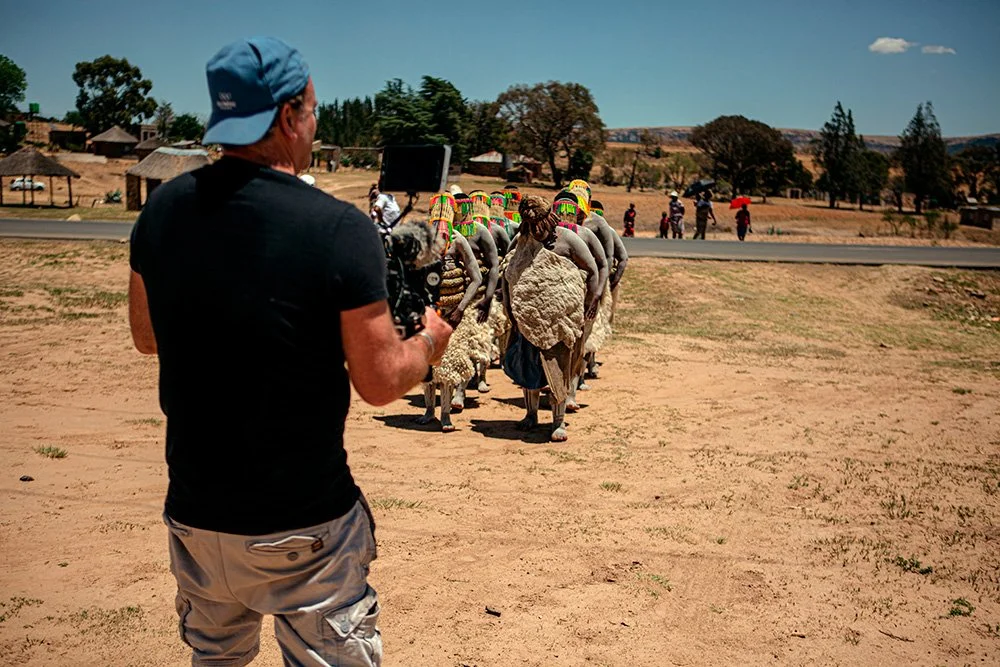reflections on CINEMATOGRAPHY
‘For most of my career, I thought cinematography was about the shot. The image. The composition. The technical craft.
But somewhere along the way, through experience, fatigue, age, travel, trauma, and growth, something shifted.
I started to realise that pointing a camera at someone is easy.
Connecting with them is the real work.
This essay is about that shift. About slowing down, listening, and learning to see people again.
When I look back at my career as a cinematographer, I can see how often I could have been more attuned to what was unfolding in front of me. I used to rush in like a bull in a China shop. I wasn’t connected to people’s feelings or energy; I was connected to the shot. Pointing a camera can be a selfish act. Your entire purpose becomes capturing a moment so you can shape a narrative. I’ve seen directors and producers push subjects to fit a story, and I’ve done it myself. I have been assertive, insistent, determined to mould a situation to suit the idea I had in my head.
As I’ve grown older, it has created a kind of reckoning. For the first time, I’ve started to question the validity of what I do. After years in this incredible job, I’ve become aware of how much desire and ego can drive us when we chase a story. We push, persuade, guide, sometimes too forcefully. And realising this has changed my philosophy. I want the process to have as much integrity as the final image. I want to connect to the people I film in a way that feels organic, honest, human.
Part of this shift comes from trying to change myself. I come from a generation where the industry rewarded urgency, bravado and entitlement. It stamped certain reactions into me. Add a restless, ADHD brain always chasing dopamine and acting before thinking, and I’m learning to slow down. To breathe. To listen. To pause before stepping into someone’s space. I’m learning to tune in, not just to others, but to myself.
What matters to me now is the emotional, psychological and energetic side of filming. We talk endlessly about cameras, lenses and technique, but the thing that truly shapes an image, human connection, is rarely discussed. When someone has lived through trauma, or carries their guard tightly around them, how do you make them feel seen? How do you reach them?
For me, cinematography is instinct. It’s sensing the room, reading the energy, knowing when to hold back and when to lean in. It’s being present enough to feel a moment rather than forcing it into an idea.
Photography has taught me the same lesson. In New York I met a guy with an incredible afro and I asked him if I could take his portrait. We connected instantly and later planned a studio shoot. He came along with his girlfriend as she was looking to do some modelling as well, but as she stepped onto the infinity curve, everything fell apart. I had imagined everything for him, but nothing for her. She wasn’t a typical model, but that wasn’t the issue. It was that I hadn’t connected with who she was. I had to stop, talk, listen, understand her energy. Only then did the portrait emerge. Pointing a camera at someone is easy; connecting with them is the real work.
The same thing happened in Cameroon when I was teaching a cinematography course. I arrived with pages of notes, ready to deliver a detailed lecture. But the filmmakers told me they didn’t have the gear we use in the West. I threw everything out and taught them what they actually needed; how to work with natural light, how to control a background, how to build an image with whatever tools they had. Those three days were an exercise in adaptability and humility. It reminded me that teaching, like filming, isn’t about imposing your agenda. It’s about meeting people where they are.
I think this is where many young cinematographers struggle today. Social media has taught them to chase immediacy, beautiful, polished images, but I find a lot of stuff emotionally detached. Everything seems to be observed from the outside rather than entering the bubble with their subjects. The work looks perfect, but it lacks warmth, intention, presence.
Cinematography isn’t just technical. It is emotional, intuitive and deeply human. The camera is only half the tool. The other half is you, your awareness, your sensitivity, your ability to connect. When you embrace that, the work becomes honest and alive. And the images you create carry a depth no piece of equipment can replicate.’
